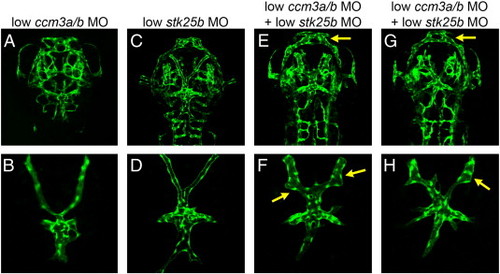FIGURE
Fig. 5
Fig. 5
|
Co-injection of suboptimal ccm3a/b (0.25 ng) and stk25b (3 ng) MO results in cranial vasculature defects at 54 hpf. Embryos injected with low doses of ccm3a/b (0.25 ng) or stk25b morpholino (3 ng) showed no obvious defects in their cranial vessels (A-D). Co-injection of both morpholinos at the same dosages resulted in gross dilation of the prosencephalic arteries (PrA), anterior cerebral veins (AceV), as well as enlargement and mispatterning of the mesencephalic veins (MsV) in 71% of the embryos (E–H, yellow arrows, n = 83). |
Expression Data
| Gene: | |
|---|---|
| Fish: | |
| Knockdown Reagents: | |
| Anatomical Term: | |
| Stage: | Long-pec |
Expression Detail
Antibody Labeling
Phenotype Data
| Fish: | |
|---|---|
| Knockdown Reagents: | |
| Observed In: | |
| Stage: | Long-pec |
Phenotype Detail
Acknowledgments
This image is the copyrighted work of the attributed author or publisher, and
ZFIN has permission only to display this image to its users.
Additional permissions should be obtained from the applicable author or publisher of the image.
Reprinted from Developmental Biology, 362(2), Yoruk, B., Gillers, B.S., Chi, N.C., and Scott, I.C., Ccm3 functions in a manner distinct from Ccm1 and Ccm2 in a zebrafish model of CCM vascular disease, 121-131, Copyright (2012) with permission from Elsevier. Full text @ Dev. Biol.

